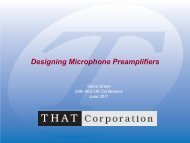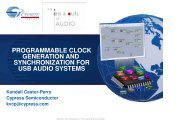The Ins and Outs of Audio
The Ins and Outs of Audio
The Ins and Outs of Audio
You also want an ePaper? Increase the reach of your titles
YUMPU automatically turns print PDFs into web optimized ePapers that Google loves.
Example #3: Class-D Amplification<br />
• Really strains the definition <strong>of</strong> “analog” audio<br />
– <strong>The</strong> technology inherently introduces unwanted artifacts into the<br />
analog output that are above the audio b<strong>and</strong><br />
– Typical switching frequencies are in the range <strong>of</strong> 200-750kHz,<br />
however harmonics can easily extend out beyond 200 MHz due to<br />
the small switching times necessary for good efficiency<br />
• <strong>The</strong> output LC filter is a potentially significant source<br />
<strong>of</strong> distortion within the audio b<strong>and</strong><br />
– <strong>The</strong> LC filter is necessary to comply with regulatory st<strong>and</strong>ards<br />
– <strong>The</strong> inductor values typically require the use <strong>of</strong> iron containing<br />
core materials which are inherently non-linear<br />
– Some more recent design topologies place the LC filter within the<br />
overall feedback loop in an attempt to reduce this distortion






